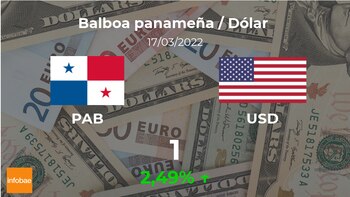
After the opening of the session, the US dollar was trading at the opening of 1 Balboa, an increase of 0.98 percent compared to the previous day's Balboa.
If we analyze this data with data from past dates, then with this value, the flat march for the previous two days stops. The recent volatility is noticeably higher than the volatility accumulated in the last year, which shows a greater change than the usual value trend.
In theannual photo, the US dollar reached 1 balboa, and the lowest level was 0.97 balboa.
Thedollar-style
balboa is a legal tender in Panama, the abbreviation PAB is used, it is also divided into hundredths and is characterized by being not an independent money, but a local version of the US dollar. Although the Panama administration issues its own coins in hundredths and balboa equivalent to dollars, these currencies are not legal bids in the United States. This is not a unique case either because the Tuvaluan and Kiribati dollars have the same relationship with the Australian dollar. This connection with the US dollar occurred in 1904 after the Panama National Convention. Since 2010, Balboa coins have been in circulation, of which 40 million units have been issued. The receipt of this currency was negative, and the Panamanian people accused him of forcibly using it to harm American banknotes, so he called the currency “Martinelli” in relation to the President of Panama Ricardo Martinelli. There was also an attempt to record two and five Balboa coins, but the project was later canceled. Currently, one hundred and a half hundred coins are in circulation. There are tenths, quarters, halves of balboas, and one balboa. In the field of economy, the International Monetary Fund (IMF) estimates that Panama, Dominican Republic and Central America will grow by 4.5% in 2022 after a 9.2% growth in 2021. Between January and December 2021, Panama accumulated 1.6% inflation, and the year-over-year fluctuation was 2.6%, according to data from the National Institute for Statistical Census (INEC). After the SARS-CoV-2 pandemic has passed, it affects many countries around the world.Agencies
Últimas Noticias
Debanhi Escobar: they secured the motel where she was found lifeless in a cistern
Members of the Specialized Prosecutor's Office in Nuevo León secured the Nueva Castilla Motel as part of the investigations into the case

The oldest person in the world died at the age of 119
Kane Tanaka lived in Japan. She was born six months earlier than George Orwell, the same year that the Wright brothers first flew, and Marie Curie became the first woman to win a Nobel Prize

Macabre find in CDMX: they left a body bagged and tied in a taxi
The body was left in the back seats of the car. It was covered with black bags and tied with industrial tape
The eagles of America will face Manchester City in a duel of legends. Here are the details
The top Mexican football champion will play a match with Pep Guardiola's squad in the Lone Star Cup

Why is it good to bring dogs out to know the world when they are puppies
A so-called protection against the spread of diseases threatens the integral development of dogs




